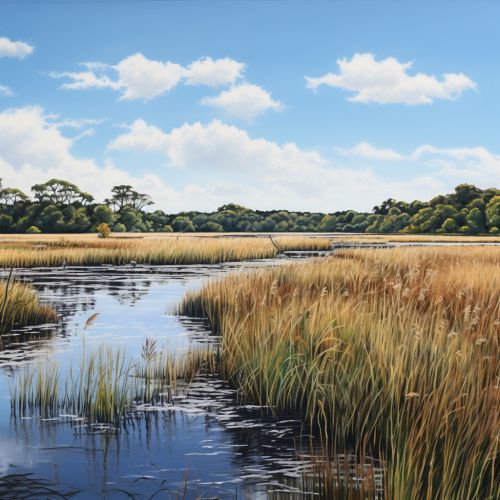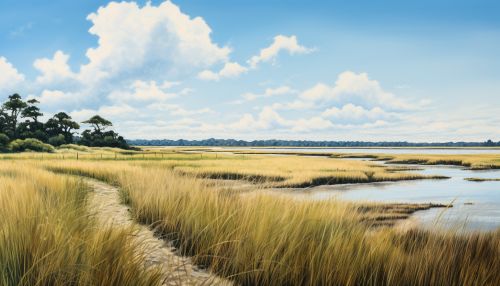Marsh
Overview
A marsh is a type of wetland that is primarily characterized by herbaceous rather than woody plant species. Marshes can often be found at the edges of lakes and streams, where they form a transition between the aquatic and terrestrial ecosystems. They are often dominated by grasses, reeds, or other emergent plants.


Formation and Types
Marshes are formed by a variety of natural processes, including the gradual filling in of lakes, the flooding of coastal areas, and the damming of rivers by beaver. There are several types of marshes, each with its own specific characteristics and plant communities. These include tidal salt marshes, tidal freshwater marshes, inland freshwater marshes, and prairie potholes.
Tidal Salt Marshes
Tidal salt marshes are found along coastlines and estuaries, and are influenced by the rise and fall of ocean tides. They are characterized by a high salt content, which influences the types of plants and animals that can survive there. The dominant plants in these marshes are salt-tolerant species like cordgrass and pickleweed.
Tidal Freshwater Marshes
Tidal freshwater marshes are found farther inland from the coast, where the influence of ocean tides is lessened. These marshes are typically dominated by a variety of grasses, sedges, and other emergent plants.
Inland Freshwater Marshes
Inland freshwater marshes are found in areas where the water table is high, such as along the edges of lakes and rivers. These marshes are often dominated by cattails, bulrushes, and other emergent plants.
Prairie Potholes
Prairie potholes are a type of inland marsh found in the central United States and Canada. They are characterized by their bowl-shaped depressions, which fill with water during the spring and provide important breeding habitat for waterfowl.
Ecology
The ecology of marshes is complex and diverse, with a wide variety of plant and animal species calling these wetlands home. Marshes are particularly important for bird species, many of which rely on these habitats for breeding and feeding. They also serve as important filters for pollutants, helping to improve water quality.
Flora
The flora of marshes is dominated by emergent plants, which are plants that grow in water but emerge above the surface. These include species like cattails, bulrushes, and reeds. In addition to these dominant species, a variety of other plants can be found in marshes, including floating plants like duckweed and submerged plants like pondweeds.
Fauna
The fauna of marshes is equally diverse, with a wide variety of invertebrates, fish, birds, and mammals calling these wetlands home. Invertebrates like dragonflies, damselflies, and mosquitoes are common, as are fish species like carp and catfish. Birds are particularly abundant in marshes, with species like ducks, geese, herons, and egrets often found in these habitats. Mammals like beavers, muskrats, and minks can also be found in marshes.
Conservation
Marshes are among the most threatened ecosystems on the planet, with many being drained for agriculture or development. This has led to a significant loss of biodiversity, as well as a decrease in the ecosystem services that these wetlands provide. Conservation efforts for marshes typically involve protecting existing marshes from further degradation, restoring degraded marshes, and creating new marshes where they have been lost.
